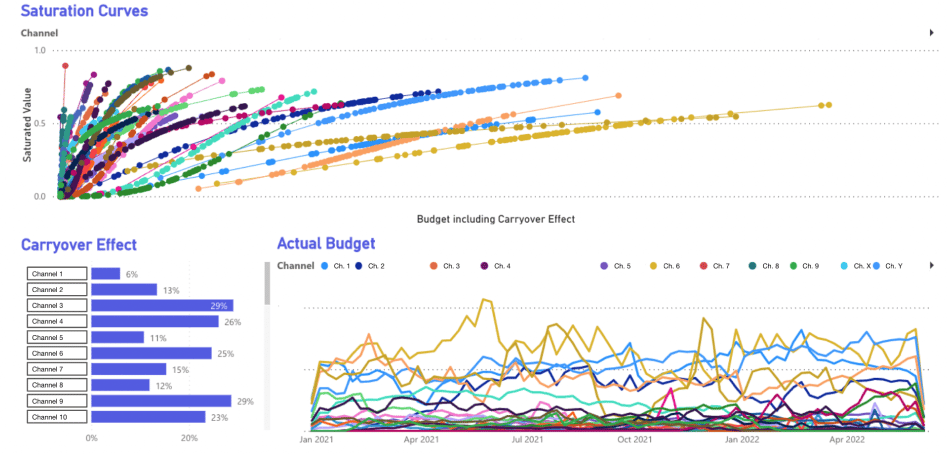Was this quote from the 1989 film Back to the Future II actually about marketing mix modeling?
Your future hasn’t been written yet. No one’s has. Your future is whatever you make it, so make it a good one.
Probably not. But the wisdom of Doc Brown holds true for today’s marketers. They’re up against plenty of challenges in today’s competitive environment. But they also have innovative tools to take hold of their marketing destiny and determine their future success.
One of those tools — marketing mix modeling, or MMM — has a reputation as a slow, arduous, technically complex method for measuring marketing channels’ impact on business outcomes. But MMM has had a makeover for the AI age, bringing it to the forefront of the data-focused marketer’s toolbox.
Making the most of precious marketing budgets
Today’s marketers face a shared obstacle: How to determine the most effective ways to use their budgets to meet their objectives. Though they may work in different industries and have diverse business models and goals, the issue of budget allocation remains consistent for all.
With that challenge comes the need to comprehend and maximize the impact of every single dollar spent. The ability to do this well can be career-defining for marketers. They need to keep the wins coming while they help build companies and shape their career trajectories.
While this is not a new challenge, it’s becoming increasingly difficult to solve. In the past, marketers have had to prioritize advertising media, such as television, newspapers, and billboards.
But today, the number of channels available has grown significantly. Modern marketers must rely on data to make informed decisions about spending that will bring measurable results. And, of course, attribution methods have also become less valuable due to limitations on audience and customer data.
The promise of marketing mix modeling
This dilemma has brought marketing mix modeling (MMM, also known as media mix modeling) back to the forefront as a powerful tool for marketers’ budget allocation. While MMM has been around for decades, there’s currently an MMM renaissance underway, for a variety of reasons:
- Companies are collecting more data than ever before. First-party data has become more of a focus for many companies as data from third-party cookies and ad platforms has become less accessible. Digital marketing data still needs to be complemented by available data from offline channels. MMM provides a way to make sense of all available historical data from all marketing channels, then use it to make informed, data-driven marketing decisions.
- Today’s competitive environment is intense, as is the pressure on marketers to show return on investment (ROI) on marketing spend. That demand has led to a greater need for accurate and actionable insights into how marketing tactics impact business performance. MMM reveals the impact of various marketing channels, non-marketing variables, and brand equity on sales and other key performance indicators (KPIs). Equipped with that information, marketing teams can optimize their efforts to boost their results.
- Finally, advancements in technology — such as machine learning and cloud computing — have enabled more robust and efficient media mix modeling. These innovations have made it more accessible to businesses of all sizes.
To build or to buy: MMM with SaaS solutions
MMM sounds pretty cool. So are you excited to hear about how can you implement MMM for free?
Well, if you have the expertise and resources in data science, statistical analysis, and data engineering, there are open-source software packages available for use. But for many companies, even those with established data science teams, implementing a custom MMM solution — even with one of those packages in hand — is a massive task.
Hiring data scientists who are proficient in marketing mix modeling methodology is one way to implement and gain full control over MMM. These professionals can create custom solutions, but they will need assistance from your data engineers and MLOps team.
Building an MMM solution in-house can be time-consuming and costly. It may take several months to develop and test an initial model. And, of course, hiring data professionals and upgrading your data infrastructure can become expensive.
As an alternative, prebuilt solutions may be more cost-effective and efficient, saving time and resources. With minimal initial investment, a ready-built MMM solution can help you rapidly measure the impact of your existing marketing efforts. You can gain insights that inform your marketing strategy and simulate what-if scenarios to see the results you might obtain from different budget allocations.
In the case of one of Pecan’s customers, using MMM resulted in the identification of $500M in overspending and opportunities for reallocation.
Pecan's MMM solution reveals channel saturation and carryover effects, plus additional insights.
Shaping your future with MMM
Marketing mix modeling is powerful and — with its AI-powered reincarnation ready for today’s data-rich world — more accessible than ever.
Ready to begin exploring the potential of MMM for your business? Check out our new guide to MMM with the vital information you need to get started and complete your marketing measurement and strategy toolbox. Make your marketing future a good one.
Start writing your marketing destiny now. Get in touch to learn more about what Pecan’s marketing mix modeling solution can do for your business.






